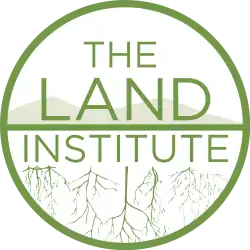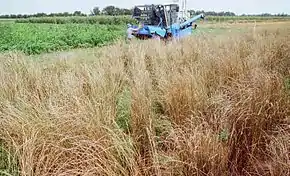The Land Institute
The Land Institute is a non-profit research, education, and policy organization dedicated to sustainable agriculture based in Salina, Kansas, United States. Their goal is to develop an agricultural system based on perennial crops that "has the ecological stability of the prairie and a grain yield comparable to that from annual crops".[5]
 | |
| Formation | 1 August 1976[1] |
|---|---|
| Founders | Wes Jackson, Dana Jackson |
| Purpose | Plant breeding |
| Location |
|
President | Fred Iutzi |
Chairman | Pete Ferrell |
Secretary | Jan Flora[3] |
Budget (2014) | $3.1 million USD[4] |
Staff (2014) | 28[4] |
| Website | landinstitute |
History
The institute was founded on 28 acres in 1976 by plant geneticist and MacArthur "genius grant" recipient Wes Jackson along with Dana Jackson, who has worked with the Land Stewardship Project in Minnesota.[1][6][7] As of 2014, the organization owns at least 879 acres of land.[4]
The Land Institute promotes "natural systems agriculture" through plant breeding.[8] Land Institute scientists are cross breeding the annual crop plants wheat, sorghum, sunflower, and legume with wild, perennial relatives to create perennial varieties.[9][10] Using selective breeding and other techniques, they also are working to domesticate wild perennials.[11] The organization's concept of developing perennial crops is modeled after the ecological design of prairies, which are known for their soil quality, deep root systems, and self-sufficiency.[8][12][13] In an interview, Wes Jackson called the concept "an inversion of industrial agriculture."[8] Perennial polyculture systems may have a variety of benefits over conventional annual monocultures such as increased biodiversity, reduced soil erosion, and reduced inputs of irrigation, fossil fuels, fertilizers, and pesticides.[14][15] Perennial crops also show promise in root-based carbon sequestration.[16][17] The organization's achievement of productive and genetically stable perennial crop plants for use by farmers is expected to take several decades.[10][12] Critics note the future economic challenge in profitably harvesting perennial polyculture.[15]
Since 1979, The Land Institute has annually hosted its Prairie Festival, which includes lectures, art displays, tours, and music performances.[18][19]
Kernza

Kernza, an intermediate wheatgrass developed by the Land Institute, is the first perennial grain crop grown across the northern United States, A perennial grain is a grain crop that lives and remains productive for two or more years. Rather than growing for only one season before harvest, like most grains and annual crops, perennial grains grow year after year. Kernza was bred over 15 years by Lee DeHaan. General Mills has announced plans to use the crop in cereal production. It is marketed as a more sustainable alternative to traditional annual crops that deplete the soil. As of April 2019, Kernza harvests in the US are still small, on the order of 500 pounds per acre. By comparison US wheat yields about 4,000 pounds per acre.[20]
The University of Minnesota has one of the largest Kernza breeding programs in the country. Scientists at the University are selectively breeding the plant to improve some of the current issues, particularly those concerning yields. Their "Forever Green Initiative" has attracted interest from large agricultural producers like General Mills and also smaller local food shops like the Birchwood Cafe.[21]
The General Mills brand Cascadian Farm plans to incorporate Kernza into some of its foods, with expectations for products made with Kernza available in retail markets by late 2019. Cascadian Farm has agreed to purchase an initial amount of the perennial grain, which is driving farmers to plant on commercial-scale fields versus the test sized plots currently being grown.
Products
Kernza breeding has dramatically increased seed size and production, hastening the timeline of commercialization, and resulting in the release of the first widely-available Kernza product, Long Root Ale from Patagonia Provisions, in 2016. The initiative and investment on the part of Patagonia Provisions to bring Long Root Ale to market led to other partnerships and potential Kernza products becoming more widely available to consumers. Currently, there are a number of restaurants serving products made with Kernza, including Birchwood Cafe in Minneapolis, Cafe Gratitude in the Los Angeles metro, and Avalanche Pizza in Athens, OH.
After the Birchwood Cafe received a 50 pound bag of grain from the University of Minnesota researchers they began baking crackers, pancakes. tortillas, and puffed grain desserts.[21]
Hopworks Urban Brewery in Portland, OR and Vancouver, WA brewed Long Root Ale for Patagonia Provisions and has it on tap, in addition to the ale in four-pack cans being sold in Whole Foods in California. Bang! Brewing in St. Paul, MN has a Kernza beer available, as does Blue Skye Brewery nearby in Salina, KS. Innovative Dumpling & Strand produces Kernza pasta that they retail through Twin Cities-area farmers’ markets.
Ecological Benefits
With perennial soil cover such as that provided by Kernza, farmers stand to greatly reduce soil erosion, potentially turning agriculture into a soil-forming ecosystem, much like the natural ecosystems it replaced. Initial research suggests that due to extensive perennial roots, Kernza and other perennial crops may nurture beneficial soil microbiomes. The frequent soil disturbance required in annual crop production is disruptive to these microbiomes.
Deeper and more abundant root systems drive healthy soil. Scientific evidence documenting the ecosystem benefits of Kernza is accumulating. Research from other perennial systems such as pastures and perennial biofuel crops provide robust evidence of the potential benefits of a perennial grain like Kernza.
For example, Paustian and colleagues published in 2016 a paper in Nature titled “Climate-Smart Soils” that compares different landscape management approaches for increasing soil carbon sequestration.[22] It is clear from their analysis that perennial grains would be a game-changer, as they could sequester carbon and maintain more cropland in production better than any alternative.[23]
Perennial Grains Story Project
The Perennial Grains Story Project is a strategic communications collaborative whose goal is to sustain enthusiasm and support for perennial grain polyculture development, and Kernza use in particular, as part of a holistic vision for more truly sustainable food production. The partnership is enhancing internal communications among Kernza users and breeders, while working to create communications products that serve the diversity of partner goals and interest.
Appearances in published works
The Land Institute's work was featured in Michael Pollan's New York Times best-seller The Omnivore’s Dilemma: A Natural History of Four Meals.[24][25] The general modus operandi of developing a sustainable, high yield, low labor, agricultural model based on the culturation of crop polycultures, developed by The Land Institute forms the substance of the chapter How Will We Feed Ourselves? in Janine Benyus's book, Biomimicry: Innovation Inspired by Nature.[26]
See also
References
- "The Land Institute Official Website: The Land Institute is Founded". Retrieved 30 December 2014.
- "The Land Institute Official Website: Contact Us". Archived from the original on 31 December 2014. Retrieved 30 December 2014.
- "The Land Institute Official Website: Board". Retrieved 30 December 2014.
- "Land Institute Official Website: Annual Report Fall 2014". Retrieved 31 December 2014.
- "The Land Institute Official Website: Vision & Mission". Retrieved 30 December 2014.
- The John D. and Catherine T. MacArthur Foundation. "Meet the 1992 MacArthur Fellows". Retrieved 2013-07-01.
- Dana L. Jackson (1 April 2002). The Farm as Natural Habitat: Reconnecting Food Systems With Ecosystems. Island Press. ISBN 978-1-59726-269-9.
- Shattuck, Kathryn (27 September 2012). "Q. and A.: Farming for an Uncertain Future". Green Blogs. The New York Times. Retrieved 30 December 2014.
- Stern, Anna (2009). "Ideas for a Better Food System :: Soil". YES! Magazine.
- Friedland, Andrew; Relyea, Rick; Courard-Hauri, David; Jones, Ross; Weisburg, Susan (2012). Environmental Science for AP. New York, New York: W.H. Freeman and Company. p. 304. ISBN 978-0-7167-3849-7. Retrieved 30 December 2014.
- Kunzig, Robert (April 2011). "Perennial Solution". National Geographic.
- Thomas J. Goreau; Ronal W. Larson; Joanna Campe (4 December 2014). Geotherapy: Innovative Methods of Soil Fertility Restoration, Carbon Sequestration, and Reversing CO2 Increase. CRC Press. p. 17. ISBN 978-1-4665-9540-8.
- Bittman, Mark (22 October 2013). "Now This Is Natural Food". The Opinion Pages. The New York Times. Retrieved 30 December 2014.
- Simon Moffat, Anne (1996-11-29). "Agricultural Research: Higher Yielding Perennials Point the Way to New Crops". Science. 274 (5292): 1469–1470. doi:10.1126/science.274.5292.1469. Retrieved 2009-07-08.
- Paul B. Thompson; W K Kellogg Chair in Agricultural Food and Community Ethics Paul B Thompson (25 July 2005). The Spirit of the Soil: Agriculture and Environmental Ethics. Routledge. pp. 123–124. ISBN 978-1-134-88442-1.
- Berman, Elizabeth; Welchel, Sarah. "Paying for Perennialism: A Quest for Food and Funding". Issues in Science and Technology.
- Fineman, Julie (30 October 2014). "San Francisco's Perennial Is Beyond Farm to Fork: A Marriage of All Things Sustainable". The Blog: Green. The Huffington Post. Retrieved 30 December 2014.
- "The Land Institute Official Website: 1st Prairie Festival". Retrieved 30 December 2014.
- Shattuck, Kathryn (2 October 2012). "Out on the Prairie, Moon, Music and Lectures, Too". Salina Journal. Salina, Kansas, USA. The New York Times. Retrieved 30 December 2014.
- "Can This Breakfast Cereal Help Save The Planet?". NPR.
- "Birchwood Cafe's pancake recipe with Kernza, a greener grain". PBS News Hour. 16 November 2019. Retrieved 22 November 2019.
- Paustian, Keith; Lehmann, Johannes; Ogle, Stephen; Reay, David; Robertson, G. Philip; Smith, Pete (April 7, 2016). "Climate-smart soils". Nature. 532 (7597): 49–57. doi:10.1038/nature17174. hdl:2164/7569.
- Friedlander, Blaine (April 6, 2016). "'Climate-smart soils' may help balance the carbon budget". Cornell Chronicle. Retrieved September 13, 2019.
- Michael Pollan (2006). The Omnivore's Dilemma: A Natural History of Four Meals. Penguin Group. ISBN 978-1-59420-082-3.
- "The 10 Best Books of 2006", The New York Times, December 12, 2006
- Benyus, Janine M (2002) [First published 1997]. "How Will We Feed Ourselves?". Biomimicry : innovation inspired by nature. New York: Perennial. ISBN 978-0-06-053322-9. OCLC 51226447.
External links
| Wikimedia Commons has media related to The Land Institute. |